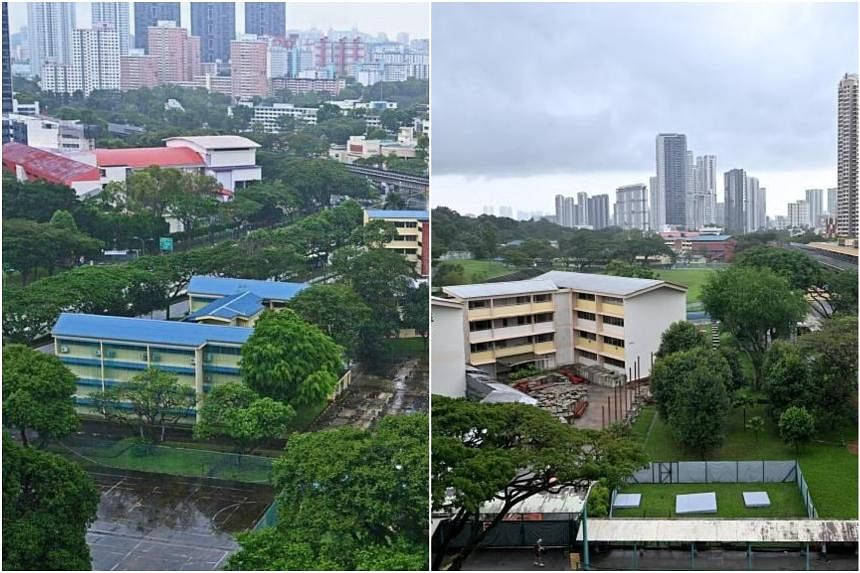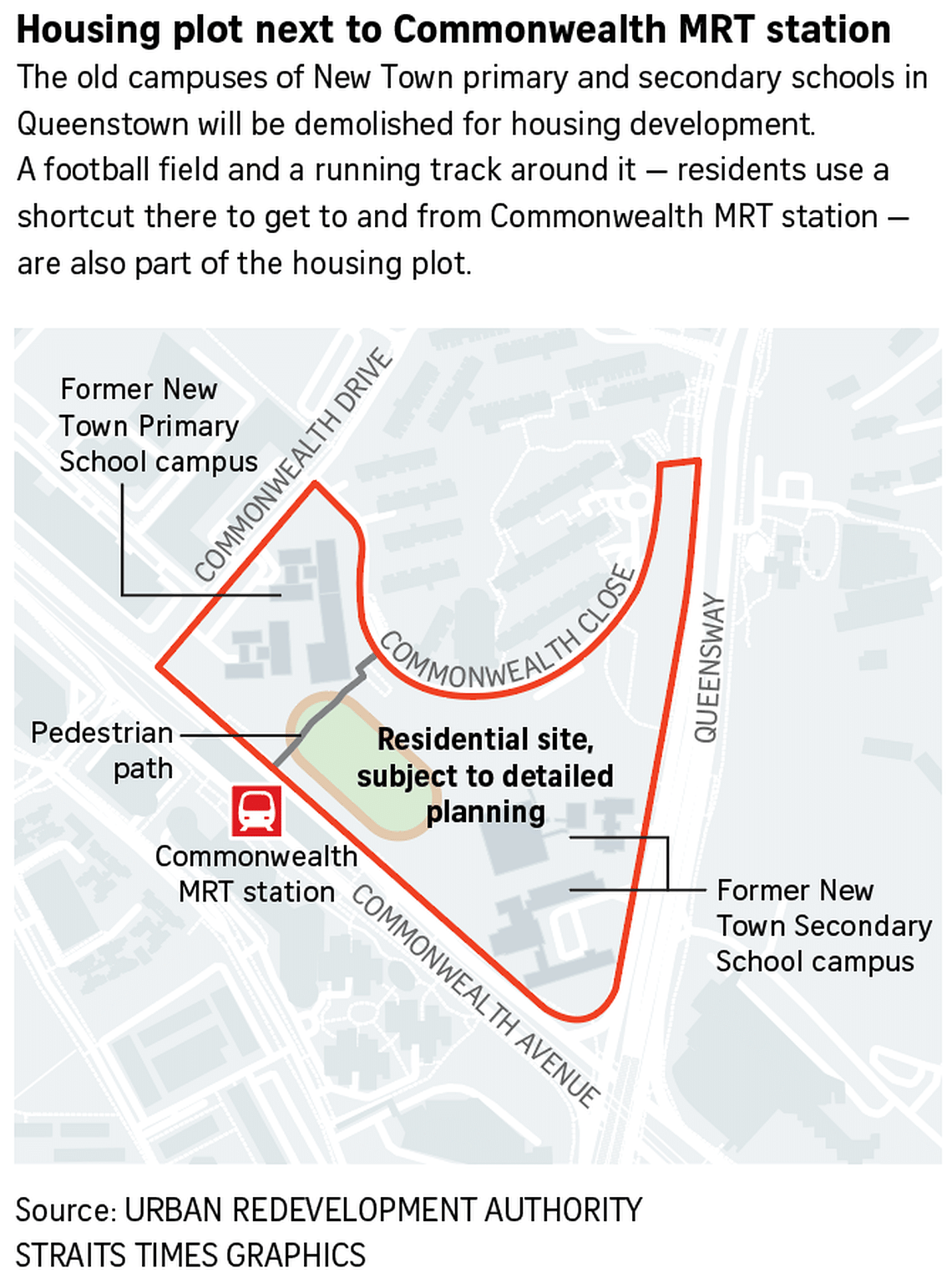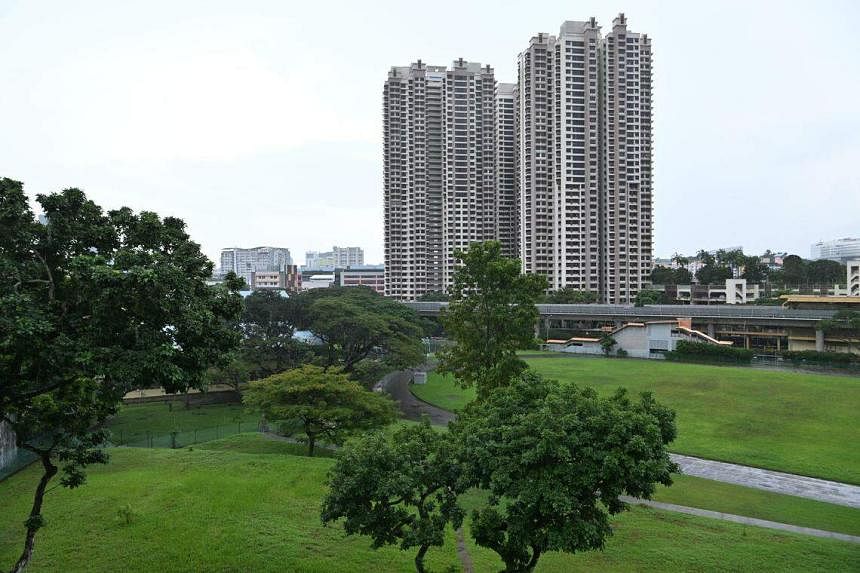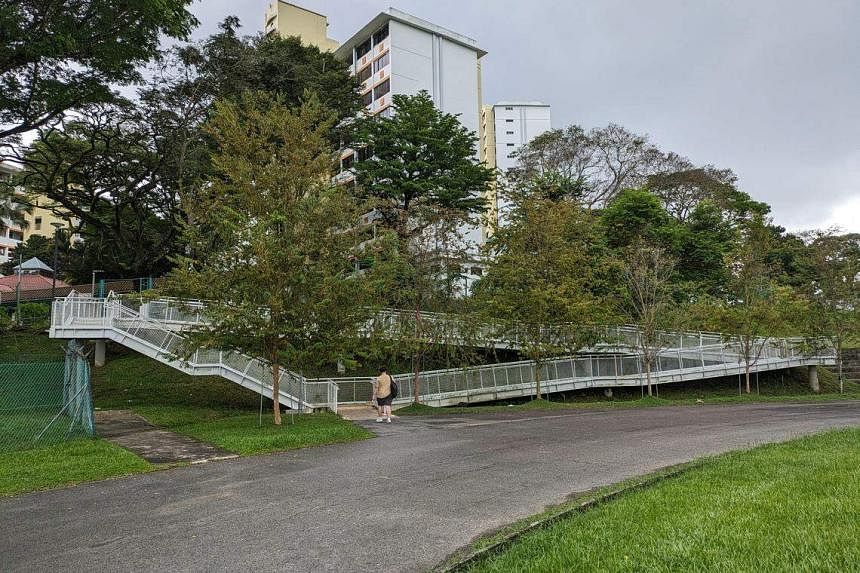2 former schools next to Commonwealth MRT station to make way for housing

SINGAPORE – Two former schools that pre-date Singapore’s independence are set to be demolished, paving the way for a plum site next to Commonwealth MRT station to be developed for housing.
The roughly 7.6ha site – equivalent in size to more than 10 football fields – houses the former New Town Primary School at 402 Commonwealth Drive, the former New Town Secondary School at 121 Queensway, as well as a track and field the two schools shared.
Property analysts said the site is suited for both public and private homes or a mix, and at about 7.6ha is large enough to house more than one project. But given current property developments in the area, they said there is no urgency to roll out new homes.
Based on the Urban Redevelopment Authority’s (URA) 2019 masterplan, the site is zoned for housing. It has yet to be assigned a gross plot ratio that determines how much development is permitted.
Responding to queries, the Housing Board (HDB) said agencies are studying plans and will announce details when ready.
It added that site preparation is under way and contractors have been appointed for the demolition of structures that will take place “over the next few years”.
When The Straits Times visited the site on Jan 25, notices to residents of nearby HDB blocks in Commonwealth Close, which abuts the site, indicated that demolition works for 402 Commonwealth Drive began on Oct 3, 2023.
A project title board at the site states that works are expected to be completed in the third quarter of 2025.
While contractors were seen in 121 Queensway, a project title board has yet to be put up, and it is unknown when demolition works will formally start and end.
New Town Primary School was officially opened on July 26, 1965 by then Finance Minister Goh Keng Swee. It was located alongside Permaisura Primary School, which opened on June 7 that year.
Mrs Margaret Anderson, 74, a teacher at New Town Primary for more than 35 years from 1967, said the two schools were originally known as Queenstown North and Queenstown South, before getting their respective names – Permaisura and New Town – as postmen would confuse the schools with Queenstown Primary School in Margaret Drive.
Sports matches among pupils, and even teachers, of New Town and Permaisura primary schools were common, she added, noting that there was no fence between their two compounds.

In 1992, New Town took over Permaisura’s campus when the latter closed down. The school relocated to 300 Tanglin Halt Road in January 2009, ending its stay of more than four decades in Commonwealth Drive.
The campus was then used as the Ministry of Education’s Heritage Centre, which opened in 2011 and closed in September 2019, before reopening in Balestier in August 2022.
New Town Secondary School was founded on Jan 2, 1965, a few months prior to the opening of its neighbour, Baharuddin Vocational School, by then Prime Minister Lee Kuan Yew on June 19 that year.
In 1969, the vocational and secondary schools were merged, with New Town taking over Baharuddin’s campus.
Mrs Anderson said the two New Town schools decided to build a sports track. She took part in several rounds of fundraising, which eventually led to the track being completed between the two schools in 1975. Plans to build a swimming pool did not materialise due to a lack of funds, she added.

New Town Secondary School eventually outgrew its Queensway campus, and at end-1998 moved to its current Dover Road site.
The compound was then used as an interim campus for seven schools over two decades – Queensway Secondary School (2000-2001), Fairfield Methodist School (Secondary) (2002-2003), River Valley High (2005-2006), Clementi Town Secondary School (2007-2008), CHIJ Theresa’s Convent (2010-2011), Assumption English School (2013-2015) and CHIJ Kellock (2017-2018).
Mr Daniel Lim, 60, who attended New Town Primary School from 1971 to 1976, said it is a pity to see the school go.
The semi-retired piano teacher fondly recalled times spent with friends, and that the canteen’s mee siam was “very good and cheap”, costing 10 cents per serving.
Also etched in his memory was a visit to the school’s ground-floor dental clinic, where he had a decayed tooth extracted in his lower primary years.
“The syringes were frighteningly large in those days,” he added.
Mrs Anderson, who was his form teacher in 1974, said the school’s doors were originally saloon-style types, which she felt were a safety hazard for pupils who might get hit by the swinging doors.
She recalled returning to school one morning to find all the doors’ copper hinges had been stolen overnight, purportedly by a thief who wanted to sell the metal parts.
“I will miss the buildings but changes are inevitable,” said the retiree.
More reluctant to accept the impending demolition is Commonwealth Close resident Catherine Leong, 72, who feels the schools are part of Queenstown’s heritage.
Ms Leong, who has lived in Block 84 for about six decades, is concerned that development of the site – the track in particular – would inconvenience residents. They have used it for exercise and as a short cut between their homes and amenities in the town such as Tanglin Halt Market, even when the schools were still in operation.
Having to skirt the former New Town Primary School – which takes thrice as long – would inconvenience residents, especially seniors, she added.

Asked about the concern, HDB said pedestrian connectivity between Commonwealth estate and Commonwealth MRT station will continue to be available “during the demolition phase and as part of future development”, but did not address the impact during potential development.
Ms Christine Sun, chief researcher and strategist at OrangeTee Group, said the site could accommodate two HDB Build-To-Order (BTO) projects, noting that the nearby 973-unit Tanglin Halt Cascadia BTO development occupies about 3.6ha.
Property portal Mogul.sg’s chief research officer Nicholas Mak added that if used entirely for private housing, the site could be divided over three to four plots.
Both said the gross plot ratio, when assigned, is likely to be on the higher end, with Ms Sun highlighting that many new BTO launches have a plot ratio of 4.2 or more to optimise land use.
Mr Mak said a plot ratio of about 4.9 to 5.1 is possible, citing the current range of 2.1 to 5.1 for other residential sites in the area. “Vacant residential land near an MRT station in the central region is rare and valuable,” he said, adding that the Commonwealth station is on the “very popular” East-West Line, thus increasing the land’s value.
Given the recent completion and ongoing development of new homes in Queenstown, Ms Sun and Mr Mak said they feel there is no urgency for the site to be developed.
Tanglin Halt Cascadia was launched in October 2023, while the HDB is slated to roll out another 250 flats as part of an upcoming integrated development in Tanglin Halt in February. These are part of the 5,500 flats that the authorities plan to build in the estate over the next 10 to 15 years.
Ahead of the integrated development’s construction, URA on Jan 26 published a proposed amendment to its masterplan for the development site, increasing its plot ratio from 2.9 to 3.5. The development is set to comprise shops, a market and hawker centre, as well as a polyclinic.


No comments
Share your thoughts! Tell us your name and class for a gift (: